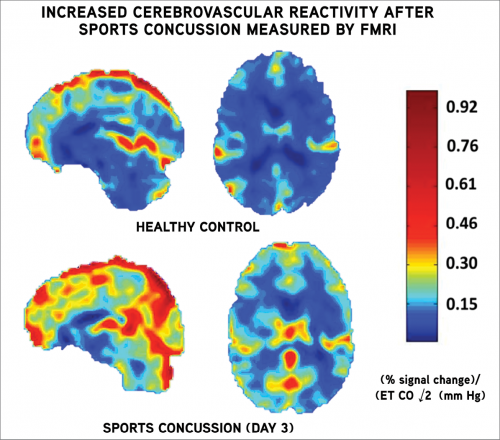Hypercarbia Challenge May Show Abnormal Brain Physiology in Concussed Athletes
Increased cerebrovascular reactivity (CVR) in college athletes following a sports-related concussion may be related to recurring headache symptoms and could be an indicator of acute injury, according to a separate study presented at RSNA 2014 by Adam R. Militana, M.D., and colleagues.
“We hope that the ability to image pathophysiology following concussion will one day inform clinical decision making,” said Dr. Militana, a third-year resident at Vanderbilt University School of Medicine.
Researchers studied four male and three female athletes (ages 18-22) three to six days following sports-related concussions diagnosed by a sports medicine physician. They had no history of prior concussion and only one noted a prior migraine condition.
Using functional MRI with a hypercarbia challenge—increased levels of carbon dioxide closely simulate the physiologic challenge that an athlete will encounter during physical activity—researchers found CVR increased approximately 33 percent across all regions of interest in the concussed athletes, compared with control patients. CVR increase was associated with more recent injury and in one region was also associated with increased headache symptoms.
“Some regions were more elevated than others, but all were increased much more than the controls,” Dr. Militana said. “This is unusual in CVR work.”
Increased CVR may be an objective measure that could be a future role for imaging in assessing return-to-play symptoms after concussion, Dr. Militana said.
“The relationship between symptoms and CVR is an area to explore as we design studies to investigate the physiological mechanism behind concussion symptoms at rest and during physical exertion,” added lead investigator Victoria L. Morgan, Ph.D., associate professor of radiology at the Vanderbilt University Institute of Imaging Science.
The research could ultimately affect patients in two ways, including assessment of the small percentage of patients who have persistent concussion symptoms well beyond impact, Dr. Morgan said.
“Moreover, if longitudinal studies can determine the typical time frame at which CVR can be expected to return to normal levels and whether this correlates with resolution of symptoms, then we will know whether symptom resolution is an accurate indicator of brain recovery,” Dr. Morgan added.

Image courtesy of Adam R. Militana, M.D., and Victoria L. Morgan, Ph.D., Vanderbilt University.